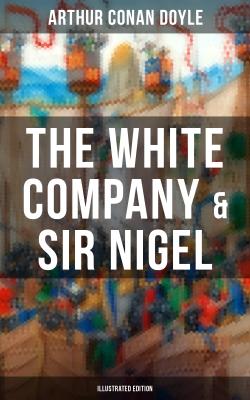The White Company & Sir Nigel (Illustrated Edition). Arthur Conan Doyle
Чтение книги онлайн.
Читать онлайн книгу The White Company & Sir Nigel (Illustrated Edition) - Arthur Conan Doyle страница 1
 ection>
ection>Arthur Conan Doyle
The White Company & Sir Nigel
(Illustrated Edition)
Historical Adventure Novels set in Hundred Years' War
Published by
Books
- Advanced Digital Solutions & High-Quality eBook Formatting -
2017 OK Publishing
ISBN 978-80-272-1936-0
Table of Contents
Sir Nigel
II. How the Devil Came to Waverley
III. The Yellow Horse of Crooksbury
IV. How the Summoner Came to the Manor House of Tilford
V. How Nigel was Tried by the Abbot of Waverley
VI. In Which Lady Ermyntrude Opens the Iron Coffer
VII. How Nigel Went Marketing to Guildford
VIII. How the King Hawked on Crooksbury Heath
IX. How Nigel Held the Bridge at Tilford
X. How the King Greeted His Seneschal of Calais
XI. In the Hall of the Knight of Duplin
XII. How Nigel Fought the Twisted Man of Shalford
XIII. How the Comrades Journeyed Down the Old, Old Road
XIV. How Nigel Chased the Red Ferret
XV. How the Red Ferret Came to Cosford
XVI. How the King’s Court Feasted in Calais Castle
XVII. The Spaniards on the Sea
XVIII. How Black Simon Claimed Forfeit from the King of Sark
XIX. How a Squire of England Met a Squire of France
XX. How the English Attempted the Castle of La Brohiniere
XXI. How the Second Messenger Went to Cosford
XXII. How Robert of Beaumanoir Came to Ploermel
XXIII. How Thirty of Josselin Encountered Thirty of Ploermel
XXIV. How Nigel was Called to His Master
XXV. How the King of France Held Counsel at Maupertuis
XXVI. How Nigel Found His Third Deed
XXVII. How the Third Messenger Came to Cosford
Introduction
Dame History is so austere a lady that if one, has been so ill-advised as to take a liberty with her, one should hasten to make amends by repentance and confession. Events have been transposed to the extent of some few months in this narrative in order to preserve the continuity and evenness of the story. I hope so small a divergence may seem a venial error after so many centuries. For the rest, it is as accurate as a good deal of research and hard work could make it.
The matter of diction is always a question of taste and discretion in a historical reproduction. In the year 1350 the upper classes still spoke Norman-French, though they were just beginning to condescend to English. The lower classes spoke the English of the original Piers Plowman text, which would be considerably more obscure than their superiors’ French if the two were now reproduced or imitated. The most which the chronicles can do is to catch the cadence and style of their talk, and to infuse here and there such a dash of the archaic as may indicate their fashion